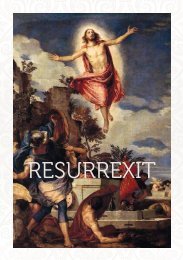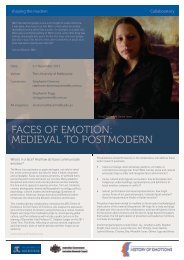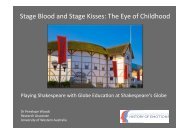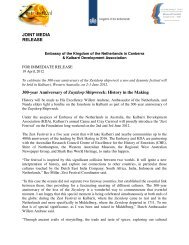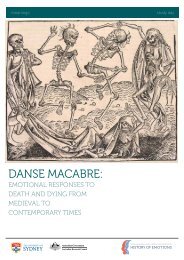Download our K-12 education pack - ARC Centre of Excellence for ...
Download our K-12 education pack - ARC Centre of Excellence for ...
Download our K-12 education pack - ARC Centre of Excellence for ...
You also want an ePaper? Increase the reach of your titles
YUMPU automatically turns print PDFs into web optimized ePapers that Google loves.
INTRODUCING THE<br />
SOUTH AFRICAN CONTEXT<br />
By Winthrop Pr<strong>of</strong>essor Susan Broomhall<br />
The lands that are now Australia and South Africa<br />
share a longer history than many know.<br />
Joined in deep time, they have geological features in common,<br />
not least a bounty <strong>of</strong> diamonds, gold and iron ore buried below<br />
the surface. Our similar, more recent British colonial history has<br />
given the region in each country where diamonds are found the<br />
name ‘the Kimberley’.<br />
The oldest recorded life <strong>for</strong>ms on the planet are found in <strong>our</strong><br />
lands. The Pilbara region <strong>of</strong> WA is host to microbes known as<br />
stromatolites some 3.2 billion years old. Stromatolites 2.5 billion<br />
years old are found in the Transvaal Supergroup <strong>of</strong> South Africa.<br />
Shark Bay’s living marine stromatolites are a mere 2000-3000<br />
years old but their scientific importance was a key part <strong>of</strong> the<br />
region being declared a World Heritage Area.<br />
From the sixteenth century, the Cape was a critical place to rest<br />
and restock European vessels making the long and perilous<br />
j<strong>our</strong>ney around Africa to reach Asia. There, they traded textiles,<br />
spices, gold and porcelain, with peoples across Asia. The<br />
governors <strong>of</strong> the Dutch East India Company (VOC <strong>for</strong> short, after<br />
the initials <strong>of</strong> its name in Dutch) realised the area’s crucial<br />
importance – it had a safe harb<strong>our</strong>, good supply <strong>of</strong> fresh water<br />
and fine soil in which crops could be grown to supply ships – and<br />
had set up a colony there by 1652. This marked the first<br />
permanent settlement by Europeans in the region.<br />
Through the activities <strong>of</strong> the VOC, the Cape and Australia became<br />
linked in a new history. The ships that were wrecked along <strong>our</strong><br />
coast came from the Cape, carrying their cargos, including<br />
elephant tusks, to <strong>our</strong> shores. These are still on display in the<br />
WA Museum Shipwreck Gallery today. On board were a mix <strong>of</strong> the<br />
world’s nations – African and Asian slaves transported far from<br />
their homelands, traders looking <strong>for</strong> a bargain, European sailors<br />
hoping to make their <strong>for</strong>tune or pay <strong>of</strong>f debts, women and<br />
children looking <strong>for</strong>ward to meeting a loved one in the dynamic<br />
VOC colony in Batavia (now Jakarta).<br />
What songs did they sing aboard and as they landed on <strong>our</strong><br />
coast Was it Calvinist hymns meant to inspire c<strong>our</strong>age and hope<br />
in those who were stranded, or jolly sea shanties that raised<br />
their spirits on the long j<strong>our</strong>neys Did slaves quietly hum songs<br />
to remind them <strong>of</strong> their childhood or work in fear <strong>of</strong> the whip to<br />
the beat <strong>of</strong> the slavetraders’ drum Sailors’ lives were also<br />
regimented by the sound <strong>of</strong> the VOC trumpeter who marked the<br />
routine phases <strong>of</strong> the day.<br />
As lands with multiple waves <strong>of</strong> migration from Europe, Africa,<br />
Asia and elsewhere, both Australia and South Africa have<br />
developed rich multi-ethnic cuisines, reflecting the origins <strong>of</strong> <strong>our</strong><br />
different populations. South Africa’s ‘rainbow cuisine’ reflects its<br />
indigenous, Dutch, Indonesian, French, and Indian peoples.<br />
‘Cape Dutch’ cooking uses the spices that the VOC brought back<br />
from its Asian trading as well as the know-how <strong>of</strong> its human<br />
cargo <strong>of</strong> slaves who served the colony.<br />
In each <strong>of</strong> <strong>our</strong> countries, the British colonial past has left deep,<br />
emotional impact upon the peoples and nations which have since<br />
emerged. We share a love <strong>of</strong> particular sports – cricket, netball<br />
and rugby among them. These were sports that were introduced<br />
under British rule during the nineteenth century. Strong ties to<br />
the idea <strong>of</strong> a British Empire have caused <strong>our</strong> peoples to go to<br />
war both as foes (the Boer, or Freedom, Wars) and as allies<br />
(World War I and World War II).<br />
From springboks to wallabies, <strong>our</strong> relative geographic isolation<br />
in the world has also given us each unique flora and fauna.<br />
The Cape boasts the smallest <strong>of</strong> six floral kingdoms in the<br />
world, with an astounding diversity in a tiny area. South-west<br />
Australia is likewise a recognised biodiversity hotspot. Eco-,<br />
safari and wildflower t<strong>our</strong>ism are now driving economic <strong>for</strong>ces<br />
<strong>for</strong> both <strong>our</strong> nations.<br />
Our geographic position has also given rise to a shared future<br />
with the world’s largest radio telescope, the Square Kilometre<br />
Array. In <strong>our</strong> remote regions, the view <strong>of</strong> the Milky Way Galaxy is<br />
best and radio interference least. This project highlights the<br />
long-held important <strong>for</strong> the stars <strong>for</strong> humans across the world.<br />
Indigenous cultures have stories to tell about the heavens, bound<br />
to their cultures and heritage. The stars were also crucial to the<br />
ability <strong>of</strong> Europeans to navigate the oceans between these lands<br />
and beyond. The SKA project between <strong>our</strong> nations ensures that<br />
<strong>our</strong> futures will be no less linked than <strong>our</strong> past.<br />
In the seventeenth century when the VOC <strong>for</strong>ged links between<br />
the lands across the ocean, the idea <strong>of</strong> liberty and the<br />
entitlements <strong>of</strong> some to access it were being hotly debated and<br />
fought out in Europe. The hard-won rights <strong>of</strong> the Dutch Republic<br />
<strong>for</strong> self-government were not extended to the African and Asian<br />
populations its sailors encountered. In different ways, each <strong>of</strong><br />
<strong>our</strong> countries has undertaken its own long j<strong>our</strong>ney <strong>of</strong> selfdiscovery<br />
to define what it means to be free, slowly integrating<br />
indigenous and migrant peoples into multicultural nations <strong>of</strong> the<br />
twenty-first century. In each, there have been confrontations<br />
between European, indigenous and migrant populations’<br />
lifestyles, ideologies and rights. Stories <strong>of</strong> slavery, exploitation,<br />
struggle and freedom have defined both <strong>of</strong> <strong>our</strong> countries.<br />
FAR FROM HOME: ADVENTURES, TREKS, EXILES & MIGRATION<br />
5





